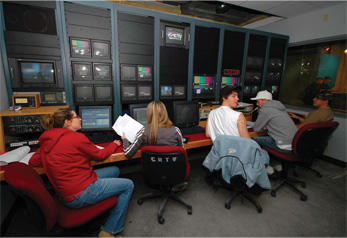Immersed In Education

- Digging Into Subject Matter And Research With 3D
- Audiovisual technology has had a key role to play in education for years, of course. From interactive whiteboards and sound field systems for teachers, to collaborative working solutions that embrace the whole classroom and, indeed, extend its reach to remote locations, schools and colleges have long been
After an installation by integrator Mechdyne, the use of 3D visualization in the classroom has given students at Iowa State a more intuitive and engaging learning experience. fertile ground for integrators.
Yet it would be a mistake to imagine that AV in education begins and ends at the whiteboard. In addition to this classroom staple, there are now many affordable high-resolution projection options to increase content display options. "It used to be that widescreen high-resolution projectors were rare and seen primarily in large venues, but now there are many small and mid-sized 2,500- to 6,500-lumen projectors that are either 1080p or 1920x1200," noted Mike Andrews, director of marketing communications for Extron. "This opens up huge potential because now you can get the resolution you need to show detailed things for science and medical learning, and it also opens up the potential for multi-windowing."
There is also another trend influencing visual display in the education setting, and that is 3D visualization. Iowabased integrator Mechdyne specializes in advanced visualization systems, and has supplied systems to more than 400 universities all over the world. Recent projects include the installation of an immersive CAVE system at Washington University in St. Louis and the upgrading of a stereoscopic display facility at Iowa State University.
"When you think about it, highend AV and virtual systems are perfectly suited for education and training," commented Mechdyne's vice president of operations, Jim Gruening. "Iowa State, for example, has a Horticultural College, and they have an application they developed for teaching students about photosynthesis and how plants get nutrients out of the ground. You see a plant growing, then you fly down to the leaf level, then the next thing you know, you're on a molecular level. And as you touch different parts of the plant, information about that part of the molecular structure comes up and educates you. Instead of looking at words or an OHP or an interactive whiteboard, you're actually inside the plant! It's a lot more intuitive and, as a student, you are much more engaged."
As the Iowa example shows, the uses of 3D visualization in the classroom extend way beyond those areas that integrators might typically associate with the technology, such as medical, military, industrial, or astronomical. If a humble plant can benefit from the 3D treatment, then so can pretty much anything. It should come as little surprise, then, that another key growth area in education is the teaching of AV disciplines themselves. With tomorrow's age set to be even more ‘visual' than today's, educators have a mission to provide students with the skills they will need to forge a career in AV production— whether that be on a stage, in a broadcast studio, or out in the field.

Canadore College recently upgraded its teaching studio with a 360 Systems Image Server supplied by Toronto-based integrator BSE. which installed the system as part of a transformation of the college's workflow from a tape-based to a server-based model.
Last fall, America's oldest technological university, Rensselaer Polytechnic Institute in Troy, NY, inaugurated its new Experimental Media and Performing Arts Center (EMPAC), which encompasses two theaters, two blackbox studios, additional studios for up to four artists in residence, an audio recording studio, and a broadcast video studio. EMPAC required a fiber-optic HD-SDI backbone for the broadcast AV and a full MADI infrastructure for digital audio, as well as over 100 wired and wireless microphone systems from the likes of Audio-Technica, DPA, Schoeps, Neumann, and Shure.
A daily selection of the top stories for AV integrators, resellers and consultants. Sign up below.
Todd Vos, lead audio engineer at EMPAC, turned to Guitar Center Pro to meet these needs, partly because the company offered a ‘one-stop shop' level of service. "One of the great things about dealing with GC Pro was that they offered product ranges at the project studio level as well as elements found in major broadcast systems," Vos commented. "Given scheduling, this was a great benefit as it was important for us to consolidate as much equipment as possible under single bids."
Once a system is installed, ongoing support is as critical in higher education as it is in any other AV application, if not more so. This can only add to an integrator's revenue stream. "AV asset management is becoming increasingly critical with everyone thinking about energy savings and ensuring that equipment is shut off when not in use," Andrews observed. "Additionally, remote support of classrooms allows operators to obtain reports on how much different pieces of equipment are being used. This creates a better idea of what technology is needed in classrooms."
Clients will find a greater return on investment with AV systems that feature a well-supported, easy-to-use control interface, Andrews added: "If you spent money on AV technology but end up with a system that is hard to operate, that creates a barrier that doesn't encourage instructors to use the technology. In a way it's wasted money. If control is easy to use and consistent from room to room, it's going to make instructors much more comfortable, and you're less likely to have an operator error."
